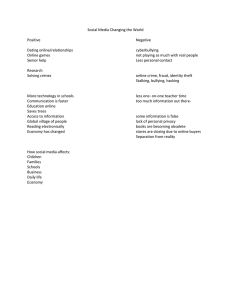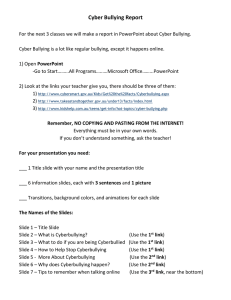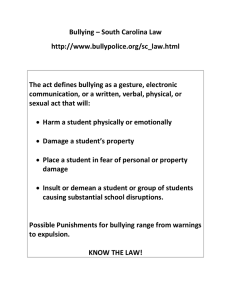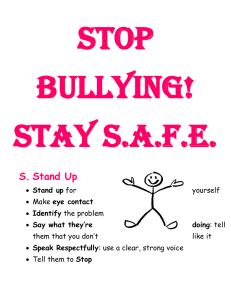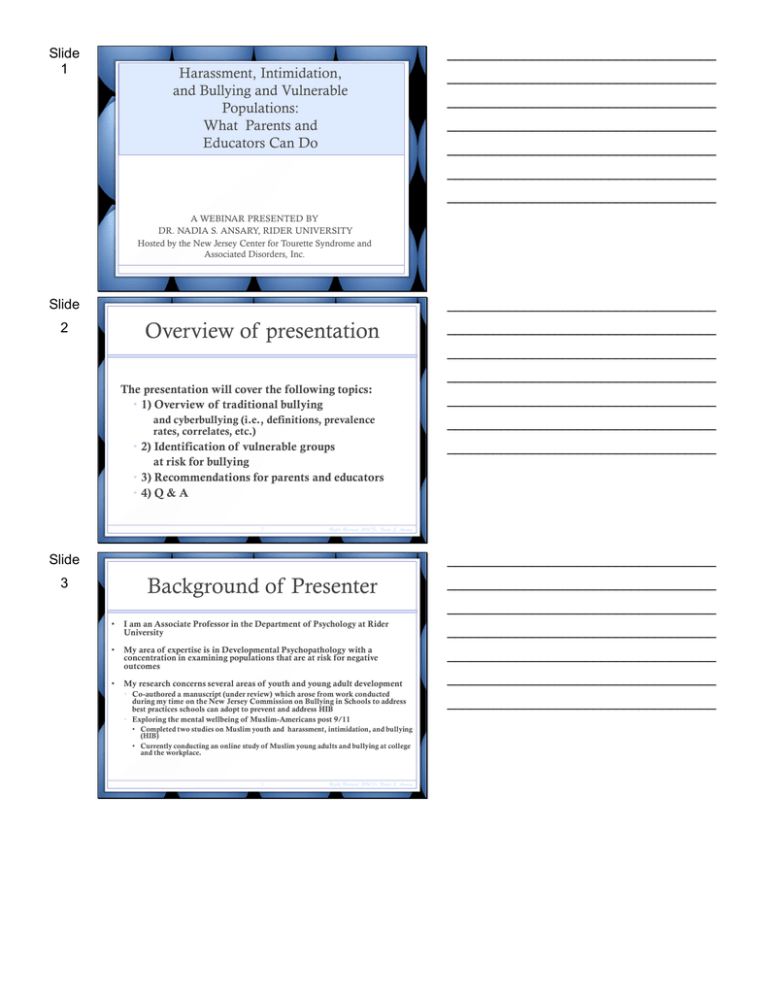
Slide
1
___________________________________
Harassment, Intimidation,
and Bullying and Vulnerable
Populations:
What Parents and
Educators Can Do
___________________________________
___________________________________
___________________________________
___________________________________
___________________________________
___________________________________
A WEBINAR PRESENTED BY
DR. NADIA S. ANSARY, RIDER UNIVERSITY
Hosted by the New Jersey Center for Tourette Syndrome and
Associated Disorders, Inc.
Slide
___________________________________
Overview of presentation
2
___________________________________
___________________________________
___________________________________
The presentation will cover the following topics:
• 1) Overview of traditional bullying
___________________________________
and cyberbullying (i.e., definitions, prevalence
rates, correlates, etc.)
___________________________________
• 2) Identification of vulnerable groups
at risk for bullying
• 3) Recommendations for parents and educators
• 4) Q & A
2
___________________________________
Rights Reserved. 2014 Dr. Nadia S. Ansary
Slide
___________________________________
Background of Presenter
3
___________________________________
___________________________________
•
I am an Associate Professor in the Department of Psychology at Rider
University
___________________________________
•
My area of expertise is in Developmental Psychopathology with a
concentration in examining populations that are at risk for negative
outcomes
___________________________________
•
My research concerns several areas of youth and young adult development
• Co-authored a manuscript (under review) which arose from work conducted
during my time on the New Jersey Commission on Bullying in Schools to address
best practices schools can adopt to prevent and address HIB
• Exploring the mental wellbeing of Muslim-Americans post 9/11
• Completed two studies on Muslim youth and harassment, intimidation, and bullying
(HIB)
• Currently conducting an online study of Muslim young adults and bullying at college
and the workplace.
3
Rights Reserved. 2014 Dr. Nadia S. Ansary
___________________________________
___________________________________
Slide
___________________________________
4
A Human Rights Concern
___________________________________
___________________________________
___________________________________
Bullying is considered
a violation of human
rights since all
children deserve to
live free of abuse and
ought to be educated
in an environment
that ensures their
safety.
___________________________________
___________________________________
___________________________________
4
Rights Reserved. 2014 Dr. Nadia S. Ansary
Slide
___________________________________
5
___________________________________
___________________________________
___________________________________
___________________________________
___________________________________
Traditional Bullying
___________________________________
Definition, Prevalence Rates, Correlates
Rights Reserved. 2014 Dr. Nadia S. Ansary
5
Slide
6
Traditional Bullying:
Definition
• The most prevalent definition of bullying was
developed by Dan Olweus (1999). Bullying is a form
of aggression that is characterized by the presence of
three unique elements:
• 1) An intent to harm
• 2) Repetition of the harmful or threatening behavior
• 3) A real or perceived power imbalance between the
• target and the child who bullies
6
Rights Reserved. 2014 Dr. Nadia S. Ansary
___________________________________
___________________________________
___________________________________
___________________________________
___________________________________
___________________________________
___________________________________
Slide
7
Traditional Bullying:
Definition
___________________________________
___________________________________
___________________________________
___________________________________
• It is important to note that there are often differences in
the scholarly and legal definitions of bullying.
___________________________________
• Difficulty in interpreting intent to harm
___________________________________
• For the purposes of the presentation, I would like to be
clear about the terms used.
• HIB
• Careful about labels (target vs. “victim”; child who bullies
vs. “the bully”)
• Bystander
___________________________________
7
Rights Reserved. 2014 Dr. Nadia S. Ansary
Slide
___________________________________
8
___________________________________
___________________________________
___________________________________
Prevalence Rates:
Traditional
Bullying
___________________________________
___________________________________
___________________________________
8
Slide
9
Rights Reserved. 2014 Dr. Nadia S. Ansary
___________________________________
Prevalence Rates at the
National Level:
Traditional Bullying
___________________________________
___________________________________
• 2013 Youth Risk Behavior Surveillance System
(Centers for Disease Control and Prevention)
• Assesses youth in grades 9-12 every two years
• Response to survey question
• “Were bullied on school property”—19.6% of youth
• No change in rates from 2009 (19.9%), 2011
(20.1%), and 2013 levels
9
Rights Reserved. 2014 Dr. Nadia S. Ansary
___________________________________
___________________________________
___________________________________
___________________________________
Slide
___________________________________
Prevalence Rates at the
National Level:
Traditional Bullying
10
___________________________________
___________________________________
• 2011 School Crime Supplement (National Center for
Education Statistics)
• Assesses youth ages 12-18 (younger sample than the
YRBSS)
• 27.8% reported being bullied
• Of those who were bullied: 24.5% Male, 31.4% Female
___________________________________
___________________________________
___________________________________
___________________________________
• Additional breakdown of data by ethnicity, grade,
household income, and school characteristics are
also available in that report
Rights Reserved. 2014 Dr. Nadia S. Ansary
10
Slide
___________________________________
Prevalence Rates at the
State Level:
Traditional Bullying
11
___________________________________
___________________________________
• New Jersey Statistics: Results of the Electronic
Violence and Vandalism Reporting System (EVVRS)
• Academic Year 2011-2012
___________________________________
___________________________________
___________________________________
• 12,024 HIB incidents reported
___________________________________
• Academic Year 2012-2013
• 7,740 incidents
• Decrease of 36%
Rights Reserved. 2014 Dr. Nadia S. Ansary
11
Slide
___________________________________
Prevalence Rates at the
State Level:
Traditional Bullying
12
New Jersey Statistics: Results of
the Electronic Violence and
Vandalism Reporting System
(EVVRS)
(Cerf et al., 2013)
___________________________________
Protected Category Breakdown
2012-2013 (Cerf et al., 2013)
Category
Percen
t
Race
15%
Most cases were verbal in
nature (77%)
Religion
2%
Ancestry
4%
•
1:3 incidents occurred in
the classroom
Sexual Orientation
12%
Gender
11%
•
More than ½ of offenders
were in middle school
Gender Expression
5%
Mental, Physical,
Sensory Disability
9%
Other Distinguishing
Characteristics
60%
•
12
Rights Reserved. 2014 Dr. Nadia S. Ansary
___________________________________
___________________________________
___________________________________
___________________________________
___________________________________
Slide
___________________________________
13
___________________________________
___________________________________
___________________________________
___________________________________
___________________________________
___________________________________
Correlates of Bullying
13
Rights Reserved. 2014 Dr. Nadia S. Ansary
Slide
___________________________________
14
Children who Bully
Targets of Bullying
___________________________________
___________________________________
• Depression and anxiety
(Arseneault et al., 2008;
Hemphill, et al., 2011;
Juvonen & Graham, 2001)
•
Poor Peer Relationships
(Nansel et al., 2001)
•
Poor school performance
and school disengagement
(Rigby, 2008)
•
Risk of Suicide and Suicide
(Rigby & Slee, 1999)
14
• Externalizing behavior
problems (e.g., law
breaking and substance
use) (Hemphill, et al.,
2011)
___________________________________
• School Disengagement
(Nansel et al., 2001; Ttofi,
Farrington, Lösel, &
Loeber, 2011)
___________________________________
___________________________________
Rights Reserved. 2014 Dr. Nadia S. Ansary
Slide
15
___________________________________
___________________________________
Bystanders
“Bully-Victims” (i.e., those
who have been targets and
have also acted as bullies)
___________________________________
___________________________________
___________________________________
• This group has
demonstrated the worst
psychological
adjustment compared
to either group alone.
(Nansel et al., 2001)
• Peers simply viewing
bullying attacks may
experience increased
anxiety
(Nishina & Juvonen, 2005)
15
Rights Reserved. 2014 Dr. Nadia S. Ansary
___________________________________
___________________________________
___________________________________
Slide
16
___________________________________
Cyberbullying
___________________________________
___________________________________
___________________________________
___________________________________
___________________________________
___________________________________
16
Rights Reserved. 2014 Dr. Nadia S. Ansary
Slide
17
___________________________________
Cyberbullying
___________________________________
___________________________________
• The participants involved in traditional bullying
are also the same parties involved in cyberbullying.
• While most of the outcomes that we expect for
traditional or offline forms of bullying are
typically seen in cases of cyberbullying, it presents
a unique challenge to targets, parents of targets, as
well as educators for many reasons.
17
___________________________________
___________________________________
___________________________________
Rights Reserved. 2014 Dr. Nadia S. Ansary
Slide
18
___________________________________
___________________________________
Cyberbullying
___________________________________
___________________________________
• Information and Communication Technologies
(ICT) have become essential to our day-to-day lives
and more importantly to our youths’ lives.
___________________________________
• While ICT provides many social and cognitive
benefits to developing children, there are also
challenges that come with it—i.e., the possibility that
ICT can be used to cause harm to others (Cassidy et
al., 2013; Dehue, 2013)
___________________________________
18
Rights Reserved. 2014 Dr. Nadia S. Ansary
___________________________________
___________________________________
Slide
___________________________________
Cyberbullying: Definition
19
___________________________________
___________________________________
“ an aggressive, intentional act
carried out by a group or
individual, using electronic forms
of contact, repeatedly and over
time against a victim who cannot
easily defend him or herself ”
___________________________________
___________________________________
___________________________________
___________________________________
(Smith et al., 2008, p. 376)
19
Slide
Rights Reserved. 2014 Dr. Nadia S. Ansary
Some examples of cyberbullying
20
(Cassidy et al., 2013)
___________________________________
___________________________________
___________________________________
Examples:
•
Physical damage to property- (e.g., sending a virus or infected file)
___________________________________
•
Verbal (e.g., using the internet or cell phone to insult or threaten)
___________________________________
• Flaming—online fights with obscene language
•
Non-verbal (e.g., sending threatening or obscene photos)
___________________________________
•
Social (e.g., exclusion from online peer group)
___________________________________
•
Indirect bullying
• Outing—sharing someone’s secrets
• Trickery--obtaining revealing/embarrassing information through deceit and
then posting
• Masquerading / impersonation (e.g., pretending to be someone else)
• Denigration—posting gossip to ruin reputation
• Voting on a defamatory polling website
20
Slide
Rights Reserved. 2014 Dr. Nadia S. Ansary
Cyberbullying: Challenges over
and above traditional bullying
21
(Dehue, 2013; Vandebosch & Van Cleemput, 2009)
CHALLENGES PRESENTED BY CYBERBULLYING
•
___________________________________
___________________________________
___________________________________
___________________________________
1) Non-verbal cues are missing from interactions
• This could lead to misinterpretation of ambiguous information as hostile
___________________________________
• It also reduces the feedback from the target received by the individual
engaging in the bullying. Depending on characteristics of the person engaged
in the bullying, this could either increase or decrease the intensity of the
bullying behavior
___________________________________
• For example, it may dampen the response if the “bully” sees the pain of
their “victim”. While for some seeing the pain of another, can increase the
intensity of the bullying behavior (Cassidy et al., 2013)
21
Rights Reserved. 2014 Dr. Nadia S. Ansary
___________________________________
Slide
Cyberbullying: Challenges over
and above traditional bullying
22
(Dehue, 2013; Vandebosch & Van Cleemput, 2009)
CHALLENGES PRESENTED BY CYBERBULLYING (con’t)
•
2) Anonymity of the perpetrator—the identity of the individual who bullies
may not be known so this can increase feelings of helplessness, and/or the
feeling that there is no safe place on the internet
•
___________________________________
___________________________________
___________________________________
___________________________________
• Acting anonymously, can in itself contribute to the power differential
(Ybarra & Mitchell, 2004)
___________________________________
•
3) The internet provides a large audience and targets may not know who has
“seen” the incident
•
4) Postings can be visible for long periods of time and can be re-posted easily
•
5) Lack of supervision by adults
Rights Reserved. 2014 Dr. Nadia S. Ansary
Cyberbullying: Challenges over
and above traditional bullying
23
___________________________________
• The individual who bullies could be a complete stranger or, alternatively,
someone the child knows
22
Slide
___________________________________
___________________________________
___________________________________
___________________________________
___________________________________
Given the fact that online posts can:
• remain on a website for long periods of time
• be re-posted
• be viewed by a large audience
___________________________________
A SINGLE ACT COULD BE CONSIDERED BULLYING WHICH IS
DIFFERENT THAN THE DEFINITION FOR TRADITIONAL
BULLYING (Cassidy et al., 2013)
___________________________________
___________________________________
• ALSO, GIVEN THE UNIQUE CHARACTERISTICS JUST
DISCUSSED, ONE COULD EASILY SEE THAT THE
EXPERIENCES OF THE TARGET CAN BE INTENSIFIED OVER
AND ABOVE WHAT MAY BE SEEN IN TRADITIONAL BULLYING
23
Rights Reserved. 2014 Dr. Nadia S. Ansary
Slide
___________________________________
24
___________________________________
___________________________________
___________________________________
Prevalence Rates:
Cyberbullying
___________________________________
___________________________________
___________________________________
24
Rights Reserved. 2014 Dr. Nadia S. Ansary
Slide
25
___________________________________
Prevalence Rates at the
National Level:
Cyberbullying
___________________________________
___________________________________
• 2013 Youth Risk Behavior Surveillance System
(Centers for Disease Control and Prevention)
• Assesses youth in grades 9-12 every two years
• Response to survey question “Were electronically
bullied”—14.8% of youth
• A decrease in rates from 2011 (16.2 %)
25
Slide
26
___________________________________
___________________________________
___________________________________
• Assesses youth ages 12-18 (younger sample than the
YRBSS)
• 9% reported being cyberbullied
27
___________________________________
___________________________________
• 2011 School Crime Supplement: National Center for
Education Statistics: School Crime
Slide
___________________________________
Rights Reserved. 2014 Dr. Nadia S. Ansary
Prevalence Rates at the
National Level:
Cyberbullying
26
___________________________________
___________________________________
___________________________________
___________________________________
___________________________________
Rights Reserved. 2014 Dr. Nadia S. Ansary
___________________________________
Prevalence Rates at the
State Level:
Cyberbullying
___________________________________
___________________________________
• New Jersey Statistics: Results of the Electronic
Violence and Vandalism Reporting System
(EVVRS)(Cerf et al., 2013)
___________________________________
• 14% of youth reported HIB by electronic
communication
___________________________________
27
Rights Reserved. 2014 Dr. Nadia S. Ansary
___________________________________
___________________________________
Slide
___________________________________
28
___________________________________
___________________________________
___________________________________
___________________________________
___________________________________
___________________________________
Cyberbullying: Correlates
28
Rights Reserved. 2014 Dr. Nadia S. Ansary
Slide
___________________________________
29
___________________________________
All the identified
correlates for traditional
bullying are the same for
cyberbullying.
29
___________________________________
___________________________________
___________________________________
___________________________________
___________________________________
Rights Reserved. 2014 Dr. Nadia S. Ansary
Slide
___________________________________
30
Children who Bully
Targets of Bullying
___________________________________
• Depression and anxiety
(Arseneault et al., 2008;
Hemphill, et al., 2011;
Juvonen & Graham, 2001)
•
Poor Peer Relationships
(Nansel et al., 2001)
•
Poor school performance
and school disengagement
(Rigby, 2008)
•
Risk of Suicide and Suicide
(Rigby & Slee, 1999)
___________________________________
30
• Externalizing behavior
problems (e.g., law
breaking and substance
use) (Hemphill, et al.,
2011)
___________________________________
• School Disengagement
(Nansel et al., 2001; Ttofi,
Farrington, Lösel, &
Loeber, 2011)
___________________________________
Rights Reserved. 2014 Dr. Nadia S. Ansary
___________________________________
___________________________________
Slide
31
___________________________________
Bystanders
“Bully-Victims” (i.e., those
who have been targets and
have also acted as bullies)
___________________________________
___________________________________
___________________________________
• This group has
demonstrated the worst
psychological
adjustment compared
to either group alone.
(Nansel et al., 2001)
• Peers simply viewing
bullying attacks may
experience increased
anxiety
(Nishina & Juvonen, 2005)
31
Slide
32
___________________________________
___________________________________
___________________________________
Rights Reserved. 2014 Dr. Nadia S. Ansary
Additional
Correlates Unique to Cyberbullying
EVIDENCE SUGGESTS THAT YOUTH WHO ENGAGE
IN CYBERBULLYING ALSO REPORT THE
FOLLOWING:
• Moral approval of bullying
___________________________________
___________________________________
___________________________________
___________________________________
___________________________________
___________________________________
• Feeling disconnected from school
___________________________________
• Lack of perceived peer support
• Underachievement
(Hinduja & Patchin, 2013)
32
Rights Reserved. 2014 Dr. Nadia S. Ansary
Slide
___________________________________
Additional
Correlates Unique to Cyberbullying
33
EVIDENCE SUGGESTS THAT YOUTH WHO ENGAGE IN
CYBERBULLYING ALSO REPORT THE FOLLOWING:
___________________________________
___________________________________
___________________________________
•
Problem behaviors (e.g. delinquency and substance use)
___________________________________
•
High level of internet usage
___________________________________
•
Some evidence of advanced computer skills
•
Poor parental monitoring
•
Children whose friends engaged in cyberbullying also tended to
do the same
___________________________________
(Hinduja & Patchin, 2013)
33
Rights Reserved. 2014 Dr. Nadia S. Ansary
Slide
___________________________________
34
___________________________________
___________________________________
___________________________________
___________________________________
___________________________________
___________________________________
Vulnerable Groups
34
Rights Reserved. 2014 Dr. Nadia S. Ansary
Slide
___________________________________
35
___________________________________
Who is at risk for being
bullied?
___________________________________
Anything that makes a child different or more
vulnerable can be considered a risk factor.
___________________________________
___________________________________
___________________________________
___________________________________
Recall the statistics from the EVVRS?
35
Rights Reserved. 2014 Dr. Nadia S. Ansary
Slide
___________________________________
36
Protected Category Breakdown 2012-2013 from
EVVRS (Cerf et al., 2013)
___________________________________
___________________________________
___________________________________
___________________________________
___________________________________
___________________________________
Rights Reserved. 2014 Dr. Nadia S. Ansary
36
Slide
___________________________________
Protected Categories
37
•
Under the New Jersey Anti-Bullying
Bill of Rights
•
Also covered under the Law Against
Discrimination (LAD)
•
Race
•
Religion
•
Ancestry
•
Sexual Orientation
•
Gender
•
Gender Expression
•
Mental, Physical, Sensory Disability
•
Other Distinguishing Characteristics
37
Slide
___________________________________
___________________________________
___________________________________
Rights Reserved. 2014 Dr. Nadia S. Ansary
Risk factors associated with being a
target:
___________________________________
___________________________________
___________________________________
___________________________________
• Difficulty asserting oneself
• Disability
• Minority status
(e.g. ethnic, religious, sexual)
• Low status within the peer group,
as well as Isolation in the peer
group
• Low SES
• Physically smaller
•
___________________________________
___________________________________
Who is at risk for being
bullied?
38
___________________________________
___________________________________
___________________________________
___________________________________
Intersection of any of these categories
creates exponential risk (for example:
An LGBT youth of Hispanic origin,
etc.)
38
Rights Reserved. 2014 Dr. Nadia S. Ansary
Slide
___________________________________
39
___________________________________
___________________________________
___________________________________
___________________________________
___________________________________
___________________________________
Recommendations for
Parents and Educators
39
Rights Reserved. 2014 Dr. Nadia S. Ansary
Slide
___________________________________
40
___________________________________
___________________________________
Recommendations for
Parents
___________________________________
___________________________________
___________________________________
___________________________________
40
Rights Reserved. 2014 Dr. Nadia S. Ansary
Slide
___________________________________
41
___________________________________
___________________________________
BE INFORMED ABOUT HOW TO PROTECT CHILDREN AND WHAT
ARE SCHOOLS’ RESPONSIBILTIES!
___________________________________
AND
___________________________________
HAVE A PAPER TRAIL (i.e., Document! Document! Document!)
___________________________________
___________________________________
41
Slide
42
Rights Reserved. 2014 Dr. Nadia S. Ansary
Bias-Based
Bullying and NJ LAD
Bias-based bullying may be a violation of the Law Against
Discrimination (LAD) if the bullying occurs in relation to the
target’s ethnicity, race, etc.
___________________________________
___________________________________
___________________________________
___________________________________
___________________________________
According to the State of NJ:
___________________________________
“The LAD applies to all schools, except for schools operated
by a bona fide religious or sectarian organization. Except for
those religious schools, all public schools, charter schools
and private schools are required to comply with the LAD.”
(State of NJ, n.d.)
http://www.state.nj.us/education/students/safety/behavior
/hib/tutorials/LAD-ABR.pdf)
42
Rights Reserved. 2014 Dr. Nadia S. Ansary
___________________________________
Slide
43
___________________________________
Bias-Based Bullying and
NJ’s Anti-Bullying Bill of Rights (ABR)
___________________________________
___________________________________
The ABR also addresses cases of bias based
bullying occurring in public schools
NJ law passed in Jan 2011 that required public
and charter schools to make policy changes
regarding bullying and implementation of an antibullying program. These changes were required
by these schools as of Sept 2011
___________________________________
___________________________________
___________________________________
___________________________________
It is considered by many to be the toughest antibullying law in the US
43
Slide
44
Rights Reserved. 2014 Dr. Nadia S. Ansary
Anti-Bullying Bill of Rights
(ABR)
___________________________________
___________________________________
___________________________________
___________________________________
The law requires:
Schools to post an anti-bullying policy on their website
To adopt an anti-bullying approach
Schools to provide a non-hostile educational
environment—much of this relates to the school culture,
values, etc.
School to have an anti-bullying specialist who is
responsible for staff training, investigation, etc.
___________________________________
___________________________________
___________________________________
Teachers and staff have the responsibility to report
incidents of bullying
A set protocol for the school’s response when an
allegation of bullying is raised.
44
Slide
45
Rights Reserved. 2014 Dr. Nadia S. Ansary
Recommendations for
Parents
• Parents must communicate with their children!
• Often targets do not tell their parents they have been
bullied due to shame. Parents usually only become
aware when the problem has become too much to
handle for the child.
• Parents must demand adequate response by the
school.
45
Rights Reserved. 2014 Dr. Nadia S. Ansary
___________________________________
___________________________________
___________________________________
___________________________________
___________________________________
___________________________________
___________________________________
Slide
Recommendations for
Parents
46
If your child is bullied, you should UNDERTAKE AND
DOCUMENT EACH OF THESE STEPS
1) contact the teacher immediately about the situation and ensure that
adequate steps are being taken to protect the child
2) follow up promptly to see what has happened to protect your child
3) If you do not receive an adequate response ensuring the child’s
continued safety, contact the principal.
___________________________________
___________________________________
___________________________________
___________________________________
___________________________________
___________________________________
___________________________________
4)In public schools, if you do not receive an adequate response
ensuring the child’s continued safety, contact the superintendent
5) If the bullying persists and the school has not adequately put in place
changes to ensure your child’s safety, you should contact a lawyer
specializing in education.
46
Rights Reserved. 2014 Dr. Nadia S. Ansary
Slide
47
___________________________________
Recommendations for Parents
___________________________________
___________________________________
___________________________________
• Know who to speak to at each level:
•
•
•
•
Elementary
Middle
High School
College Level
___________________________________
___________________________________
___________________________________
47
Rights Reserved. 2014 Dr. Nadia S. Ansary
Slide
48
___________________________________
Recommendations for Parents
___________________________________
___________________________________
CYBERBULLYING
___________________________________
• Monitoring can be challenging and there is
mixed evidence about its efficacy. This is less
likely to be a result of “monitoring doesn’t
matter” and more likely to be related to the
difficulty in parental monitoring of ICT used
by youth. That being said, parents must strive
to continuously monitor ICT use as much as
they can.
48
Rights Reserved. 2014 Dr. Nadia S. Ansary
___________________________________
___________________________________
___________________________________
Slide
___________________________________
Recommendations for Parents
49
___________________________________
CYBERBULLYING
• One of the major challenges for parents, is the
gap between generations in understanding and
use of ICT. To typify this disconnect Prensky
(2001), has coined the terms “digital natives”
and “digital immigrants” to characterize
children and parents respectively.
• Sanctions--When children expect sanctions from
parents or school, they were significantly less
likely to report involvement in cyberbullying
(Hinduja & Patchin, 2013)
49
___________________________________
___________________________________
___________________________________
___________________________________
___________________________________
Rights Reserved. 2014 Dr. Nadia S. Ansary
Slide
___________________________________
Recommendations for Parents
50
___________________________________
• CYBERBULLYING
•
___________________________________
Parents should instruct their children about safe use of ICT.
• not to share usernames or passwords
• not to give out personal information in profiles, chat rooms, etc.
___________________________________
___________________________________
• not to respond to threatening messages and to notify an adult
immediately
___________________________________
• to shut off the phone or log off if a threatening message is sent
via text or IM
___________________________________
• to be careful about sending personal photos of yourself
(especially concerning “sexting”)
• repeatedly, that once something is posted or sent, it cannot be
taken back!
(www.girlshealth.gov)
50
Slide
51
Rights Reserved. 2014 Dr. Nadia S. Ansary
Recommendations for Parents
___________________________________
___________________________________
___________________________________
___________________________________
Ways of handling cyberbullying
• Immediate responses to cyberbullying include:
• Passive strategies (e.g., do nothing, avoid website)
• Active strategies (e.g., confront, tell to stop, block)
•
Perren and colleagues (2012) found that active strategies
actually exacerbated the problem
• Even in spite of this early evidence, the literature is still not very
clear about effective strategies for immediately handling
cyberbullying (Perren et al., 2012)
51
Rights Reserved. 2014 Dr. Nadia S. Ansary
___________________________________
___________________________________
___________________________________
Slide
___________________________________
52
___________________________________
___________________________________
Recommendations for
Schools
___________________________________
___________________________________
___________________________________
___________________________________
52
Rights Reserved. 2014 Dr. Nadia S. Ansary
Slide
___________________________________
53
___________________________________
Fostering a Positive School Climate is
at the Foundation of any Effective
Anti-Bullying Approach
___________________________________
___________________________________
___________________________________
THIS IS PARTICULARLY SALIENT WHEN
CONSIDERING BULLYING & VULNERABLE YOUTH
___________________________________
___________________________________
53
Rights Reserved. 2014 Dr. Nadia S. Ansary
Slide
54
___________________________________
Support For
Vulnerable Student Groups
___________________________________
___________________________________
___________________________________
• Report and tracking of bullying is critical not just from a legal
standpoint but also to identify if certain vulnerable groups of
students are being targeted with greater frequency
___________________________________
• Instances of bias-based bullying should also be viewed as
catalysts for school climate re-evaluation
___________________________________
54
Rights Reserved. 2014 Dr. Nadia S. Ansary
___________________________________
Slide
Support For
Vulnerable Student Groups
55
___________________________________
___________________________________
___________________________________
___________________________________
• Thus…
• Schools need to be especially careful to provide support to
minority youth and youth with disabilities (e.g., sponsoring
support programs for their groups; ensuring they are
included as active participants in the school’s anti-bullying
programs).
• Schools need to be especially careful to provide support to
PARENTS of MINORITY YOUTH and YOUTH with
DISABILITIES - These parents may be recent immigrants
or simply may not understand their rights (e.g., translating
HIB- related policies into the most common languages
spoken in their community or applying it to their child who
has a disability; reaching out to community members who
are willing to volunteer , translate, give support, share
information and resources, etc.).
55
___________________________________
___________________________________
___________________________________
Rights Reserved. 2014 Dr. Nadia S. Ansary
Slide
___________________________________
Support For
Vulnerable Student Groups
56
• All typical strategies for preventing and effectively
intervening when HIB occur (e.g., teacher training,
monitoring locations known for increased bullying such
as hallways, lunch, buses, etc., outlined protocol to be
followed when HIB occurs) are especially critical when
handling bias-based bullying.
___________________________________
___________________________________
___________________________________
___________________________________
___________________________________
___________________________________
• Training teachers and personnel on how to identify and
address HIB in all cases but especially so when biasbased bullying occurs is critical, Training is especially
salient in preventing teacher perpetrated events as well as
professional development to optimize identification and
appropriate management of HIB in the classroom.
56
Rights Reserved. 2014 Dr. Nadia S. Ansary
Slide
___________________________________
RECOMMENDATIONS
FOR SCHOOLS
57
___________________________________
___________________________________
___________________________________
CYBERBULLYING
•
As cited in Cassidy and colleagues (2013), cyberbullying was found to be
related to events begun in school and has been found to impact the school
day. Therefore, schools have a responsibility to address this issue. NJ ABR
law requires this.
•
The recommendations for traditional bullying are also potent in addressing
cyberbullying
• Evidence is relatively clear that fostering a positive school climate is the key to
preventing traditional bullying and cyberbullying
• Cyberbullying must be addressed explicitly in a school’s HIB policy
• When children expect sanctions from parents or school, they were significantly less
likely to report involvement in cyberbullying (Hinduja & Patchin, 2013)
• Address traditional bullying and cyberbullying in curriculum
• Teacher training on traditional bullying and cyberbullying
57
Rights Reserved. 2014 Dr. Nadia S. Ansary
___________________________________
___________________________________
___________________________________
Slide
___________________________________
Resources about bullying for
parents and educators
58
US Department of Health and Human Services – Stop Bullying Website http://www.stopbullying.gov/
New Jersey Coalition for Bullying Awareness and Prevention—Has a hotline http://njbullying.org
National School Climate Center’s 12 Dimensions of School Climate retrieved at
http://www.schoolclimate.org/programs/documents/dimensions_chart_pagebars.pdf
NJDOE Essential Dimensions and Considerations for Safe and Supportive School Conditions retrieved at
http://homeroom.state.nj.us/evvrs/HIB_11-15.pdf
NJDOE Keeping our Kids Safe, Healthy, and in School http://www.state.nj.us/education/students/safety/behavior/hib/
Safe Communities, Safe Schools Fact Sheet retrieved at
http://www.colorado.edu/cspv/publications/factsheets/safeschools/FS-SC07.pdf
SAMSHA – CSAP Prevention Pathways – The ABCs of Bullying
http://pathwayscourses.samhsa.gov/bully/bully_1_pg5.htm
State of New Jersey retrieved at
http://www.state.nj.us/education/students/safety/behavior/hib/tutorials/ LAD-ABR.pdf)
58
___________________________________
___________________________________
___________________________________
___________________________________
___________________________________
___________________________________
Rights Reserved. 2014 Dr. Nadia S. Ansary
Slide
___________________________________
Thank you for your time
and attention!
59
___________________________________
___________________________________
• Questions Welcomed!
___________________________________
• Contact information:
___________________________________
Dr. Nadia S. Ansary
___________________________________
Associate Professor
___________________________________
Rider University, Department of Psychology
nansary@rider.edu
609-895-5433
59
Rights Reserved. 2014 Dr. Nadia S. Ansary
Slide
___________________________________
References
60
•
Arseneault, L., Milne, B. J., Taylor, A., Adams, F., Delgado, K., Caspi, A., Moffitt, T. E. (2008). Being bullied as an
environmentally mediated contributing factor to children’s internalizing problems: A study of twins discordant for
victimization. Archives of Pediatric Adolescent Medicine, 162(2), 145-150.
•
Cassidy, W., Faucher, C., & Jackson, M. (2013). Cyberbullying among youth: A comprehensive review of current
international research and its implications and application to policy and practice. School Psychology International, 1-38.
doi 10.1177/0143034313479697
•
Dehue, F. (2013). Cyberbullying research: New perspectives and alternative methodologies. Introduction to the special
issue. Journal of Community & Applied Psychology, 23, 1-6.
•
Cerf, C. D., Martz, S., Curry, N. (2013, December). Commissioner’s annual report to the Education Committees of the
Senate and General Assembly on Violence, Vandalism, and Substance Abuse in New Jersey Public Schools: July 1 to June
20, 2013. Retrieved on November 12, 2014 from http://www.state.nj.us/education/schools/vandv/1213/vandv.pdf
•
Hemphill. S. A., Kotevski, A., Herrenkohl, T. I., Bond, L., Kim, M. J., Toumbourou, J. W., & Catalano, R. F. (2011).
Longitudinal consequences of adolescent bullying perpetration and victimisation: A study of students in Victoria,
Australia. Criminal Behaviour and Mental Health, 21, 107-116.
•
Hinduja, S., & Patchin, J. W. (2013). Social influences on cyberbullying behaviors among middle and high school
students. Journal of Youth & Adolescence, 42, 711-722. doi 10.1007/s10964-012-9902-4.
•
Nishina, A., & Juvonen, J. (2005). Daily reports of witnessing and experiencing peer harassment in middle school. Child
Development, 76, 435–450.
Rights Reserved. 2014 Dr. Nadia S. Ansary
60
___________________________________
___________________________________
___________________________________
___________________________________
___________________________________
___________________________________
Slide
___________________________________
References
61
___________________________________
___________________________________
•
Juvonen, J., & Graham, S. (2001). Research-based interventions on bullying. In C. E. Sanders, & G. D. Phye (Eds.), Bullying
Implications for the classroom (pp.229-255): San Diego, California: Elsevier
•
Nansel, T.R., Overpeck, M., Pila, R.S., Ruan, W. J., Simon-Morton, B., & Scheidt, P. (2001). Bullying behavior among U.S.
youth: Prevalence and association with psychosocial adjustment. Journal of the American Medical Association, 285, 20942100.
•
National Center for Education Statistics and Bureau of Justice Statistics.(n.d.) 2011 School Crime Supplement. Retrieved
November 10, 2014 from http://nces.ed.gov/pubsearch/pubsinfo.asp?pubid=2013329
•
National Center for Education Statistics and Bureau of Justice Statistics.(n.d.) 2011 School Crime Supplement. Retrieved
November 10, 2014 from http://nces.ed.gov/pubsearch/pubsinfo.asp?pubid=2013329
•
Nishina, A., & Juvonen, J. (2005). Daily reports of witnessing and experiencing peer harassment in middle school. Child
Development, 76, 435–450.
•
Olweus, D. (1999). Sweden. In P. K. Smith, Y. Morita, J. Junger-Tas, D. Olweus, R.Catalano, and P. Slee (Eds.), The nature of
school bullying: A cross-national perspective (pp. 7-27). London: Routledge.
•
Perren, S., Corcoran, L., Cowie, H., Dehue, F., Garcia, D., Mc Guckin, C., et al. (2012). Coping with cyberbullying: A systematic literature review. Final
Report of the COST IS 0801 Working Group 5 (published online). : A systematic literature review. Final Report of the COST IS 0801 Working Group
5 (published online).
•
Prensky, M. (2001). Digital natives, digital immigrants. On the Horizon, 9(5), 1-6, doi: 10.1108/10748120110424816.
61
___________________________________
___________________________________
___________________________________
___________________________________
Rights Reserved. 2014 Dr. Nadia S. Ansary
Slide
___________________________________
References
62
___________________________________
___________________________________
•
Rigby, K. (2008). Children and bullying: How parents and educators can reduce bullying at school. MA, USA:
Blackwell.
•
Rigby, K., & Slee, P. T., (1999). Suicidal ideation among adolescent school children, involvement in bully/victim
problems, and perceived low social support. Suicide and Life Threatening Behavior, 29, 119-130.
•
Smith, P. K., Mahdavi, J., Carvalho, M., Fisher, S., Russell, S., & Tippett, N.(2008). Cyberbullying: Its nature and
impact in secondary school pupils. Journal of Child Psychology and Psychiatry, 49, 376–385. doi:10.1111/j.14697610.(2007).01846.x
•
Ttofi, M. M., Farrington, D. P., Lösel, F., & Loeber, R. (2011). The predictive efficiency of school bullying versus
later offending: A systematic/meta-analytic review of longitudinal studies. Criminal Behaviour and Mental
Health, 21, 80-89.
•
Ybarra, M. L., & Mitchell, K. J. (2004). Online aggressor/targets, aggressors, and argets,: A comparison of
associated youth characteristics. Journal of Child Psychology and Psychiatry, 45(7), 1308-1316.
•
Youth Risk Behavior Surveillance System: CDC Trends in the prevalence of behaviors that contribute to violence:
National YRBS: 1991-2013. Retrieved November 10, 2014 from
http://www.cdc.gov/healthyyouth/yrbs/pdf/trends/us_violence_trend_yrbs.pdf
•
Vandebosch, H., & Van Cleemput, K. (2009). Cyberbullying among youngsters: profiles of bullies and victims. New
Media Society, 11, 1349-1371.
62
Rights Reserved. 2014 Dr. Nadia S. Ansary
___________________________________
___________________________________
___________________________________
___________________________________

